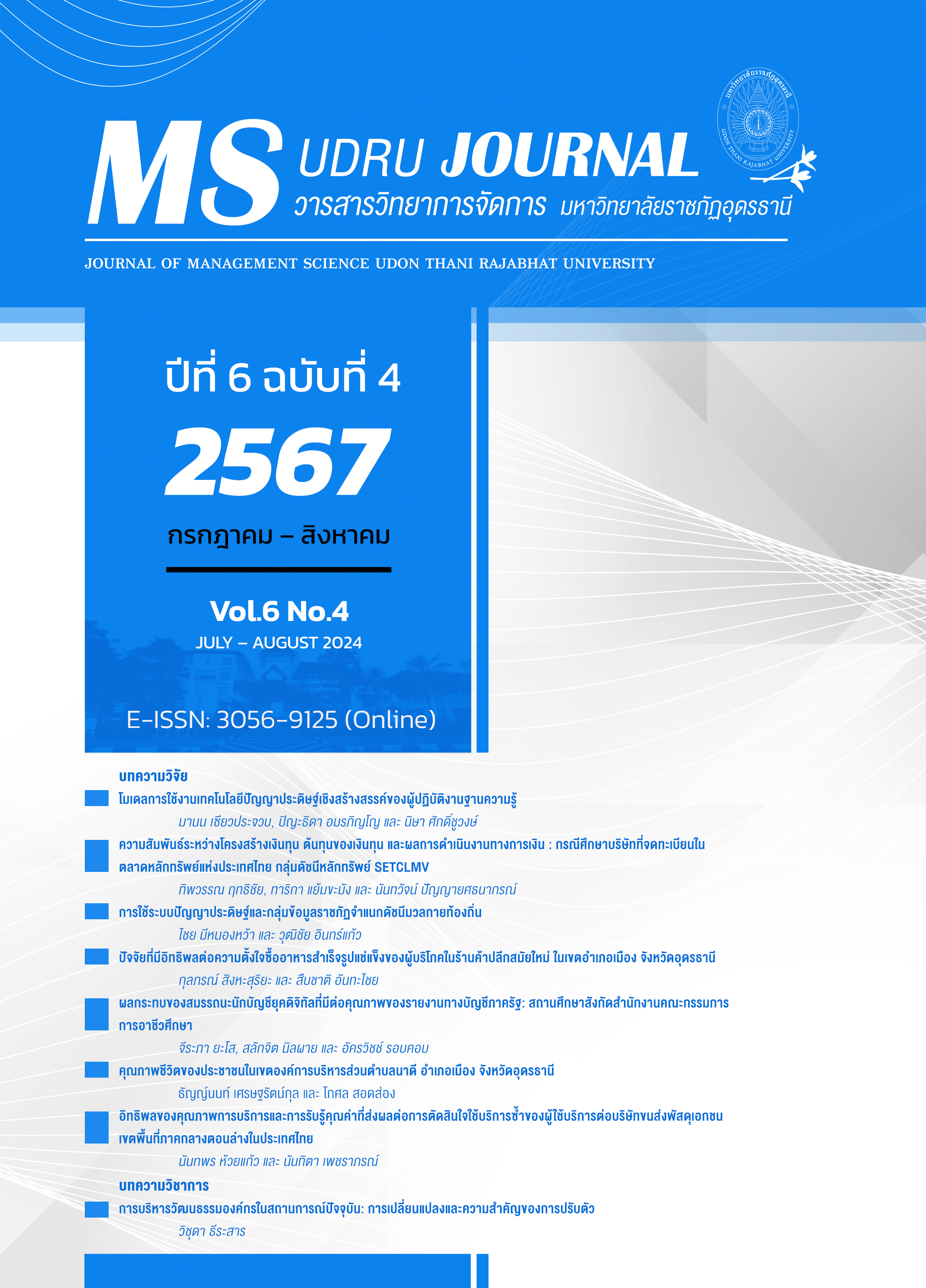โมเดลการใช้งานเทคโนโลยีปัญญาประดิษฐ์เชิงสร้างสรรค์ของผู้ปฏิบัติงานฐานความรู้
Main Article Content
บทคัดย่อ
การวิจัยในครั้งนี้มีวัตถุประสงค์เพื่อ 1) เพื่อพัฒนาโมเดลปัจจัยเชิงสาเหตุในการยอมรับและใช้งานเทคโนโลยีปัญญาประดิษฐ์เชิงสร้างสรรค์ และ 2) เพื่อศึกษาตัวแปรเชิงสาเหตุที่มีอิทธิพลต่อความตั้งใจเชิงพฤติกรรมการใช้งานเทคโนโลยีปัญญาประดิษฐ์เชิงสร้างสรรค์ กลุ่มตัวอย่างคือผู้ปฏิบัติงานฐานความรู้ที่ใช้งานเทคโนโลยีปัญญาประดิษฐ์เชิงสร้างสรรค์ จำนวน 400 คน สุ่มตัวอย่างแบบหลายขั้นตอน เก็บข้อมูลด้วยแบบสอบถามแบบ 5 ระดับ ทำการวิเคราะห์สถิติเชิงอนุมานด้วยการวิเคราะห์ความสัมพันธ์เชิงโครงสร้างโดยใช้โมเดลสมการโครงสร้างตามความแปรปรวนร่วม
ผลการวิจัยพบว่า ตัวแปรแฝงมุมมองต่อเทคโนโลยี สมรรถนะส่วนบุคคล สมรรถนะองค์กรและอิทธิพลทางสังคมส่งผ่านอิทธิพลทางตรงเชิงบวกผ่านการรับรู้ความยากง่ายในการใช้งานไปยังความตั้งใจเชิงพฤติกรรมการใช้งาน และตัวแปรแฝงมุมมองต่อเทคโนโลยี สมรรถนะส่วนบุคคล และสมรรถนะองค์กรส่งผ่านอิทธิพลทางตรงเชิงบวกผ่านการรับรู้ประโยชน์ในการใช้งาน ไปยังความตั้งใจเชิงพฤติกรรมการใช้งานเทคโนโลยีปัญญาประดิษฐ์เชิงสร้างสรรค์
Article Details

อนุญาตภายใต้เงื่อนไข Creative Commons Attribution-NonCommercial-NoDerivatives 4.0 International License.
บทความที่ได้รับการตีพิมพ์เป็นลิขสิทธิ์ของคณะวิทยาการจัดการ มหาวิทยาลัยราชภัฏอุดรธานี
ข้อความที่ปรากฏในบทความแต่ละเรื่องในวารสารวิชาการเล่มนี้
ไม่ใช่ความคิดเห็นและความรับผิดชอบของผู้จัดทำ บรรณาธิการ กองบรรณาธิการ และคณะวิทยาการจัดการ มหาวิทยาลัยราชภัฏอุดรธานี ความรับผิดชอบด้านเนื้อหาและการตรวจร่างบทความแต่ละเรื่องเป็นความคิดเห็นของผู้เขียนบทความแต่ละท่าน
เอกสารอ้างอิง
นิษา ศักดิ์ชูวงษ์. (2565). ปัจจัยเชิงสาเหตุที่มีอิทธิพลต่อความตั้งใจเชิงพฤติกรรมในการใช้งานแอปพลิเคชันถุงเงินของผู้ประกอบการในจังหวัดอุดรธานี. วารสารสังคมศาสตร์และมานุษยวิทยาเชิงพุทธ, 7(2), 294-309.
มานน เซียวประจวบ และนิษา ศักดิ์ชูวงษ์. (2562). การพัฒนาตัวบ่งชี้ปัจจัยที่กำหนดการยอมรับเทคโนโลยีชำระเงินผ่านช่องทางออนไลน์ของผู้บริโภคในจังหวัดอุดรธานี. วารสารคณะวิทยาการจัดการ มหาวิทยาลัยราชภัฎอุดรธานี, 1(1), 1-16.
วลัยลักษณ์ คงพระจันทร์. (2023). มาตรฐาน AI” สำคัญอย่างไร จำเป็นแค่ไหน กับวงการ AI ประเทศไทย. สืบค้น มีนาคม 14, 2567 จาก https://www.nectec.or.th/news/news-article/ai-thailand-standard.html.
เสาวลักษณ์ เขตสูงเนิน. (2023). สู้ศึก AI โลกล้อมไทย! เปิดแผน AI Thailand ที่มาพร้อมเป้าหมายเจาะเศรษฐกิจอาเซียน 1.9 พันล้านล้านบาทให้สำเร็จใน 7 ปี. สืบค้น มีนาคม 14, 2567 จาก https://thestandard.co/ai-thailand-asean-economy/.
Al-Adwan, A. S., Li, N., Al-Adwan, A., Abbasi, G. A., Albelbisi, N. A., & Habibi, A. (2023). Extending the technology acceptance model (TAM) to predict university students' intentions to use Metaverse-based learning platforms. Education and Information Technologies, 28, 15381–15413.
Bangkok Bank InnoHub. (2023). ทำความรู้จัก Generative AI ทั้ง 5 ประเภทที่ช่วยผลิตงานสร้างสรรค์ได้อย่างมีประสิทธิภาพ. สืบค้น 14 มีนาคม 2567, จาก https://www.bangkokbankinnohub.com/5-types-of-generative-ai-tools-to-unlock-your-creativity/.
Cazzaniga, M., Jaumotte, F., Li, L., Melina, G., Panton, A. J., Pizzinelli, C., Rockall, E. J., & Tavares, M. M. (2024). Gen-AI: Artificial intelligence and the future of work. from https://www.imf.org/en/Publications/Publications-By-Subject?subject=Artificial%20Intelligence.
Certo, S. C., & Certo, S. T. (2012). Modern management: Concepts and skills (12th ed.). New Jersey: Prentice Hall.
Cochran, W. G. (1977). Sampling techniques (3rd ed.). New York: John Wiley & Sons.
Davis, F. D., Bagozzi, R. P., & Warshaw, P. R. (1989). User Acceptance of Computer Technology: A Comparison of Two Theoretical Models. Management Science, 35 (8), 982-1003.
Dwi, A., Mumtaza, A. R., Denia, S., & Jingga, F. (2022). Cryptocurrency Exchange Application Acceptance with TAM Model in Indonesia. In Proceedings of the International Conference on Industrial Engineering and Operations Management. March 7-10, 2022, (pp. 4625-4637). Istanbul: Turkey.
Fornell, C., & Larcker, D. F. (1981). Structural Equation Models with Unobservable Variables and Measurement Error: Algebra and Statistics. Journal of Marketing Research, 18, 382-388.
Gangwar, H., Date, H., & Ramaswamy, R. (2015), "Understanding determinants of cloud computing adoption using an integrated TAM-TOE model". Journal of Enterprise Information Management, 28(1), 107-130.
Hair Jr., J. F., Black, W. C., Babin, B. J. & Anderson, R. E. (2010) Multivariate Data Analysis: A Global Perspective. (7th ed.). Upper Saddle: Pearson Education.
Henseler, J., & Sarstedt, M. (2013). Goodness-of-fit indices for partial least squares path modeling. Computational Statistics, 28(2), 565-580.
Holt, D. T., Armenakis, A. A., Feild, H. S., & Harris, S. G. (2007). Readiness for organizational change: The systematic development of a scale. The Journal of Applied Behavioral Science, 43(2), 232-255.
Inc. (2023). A Survey of 31,000 Employees Shows 49 Percent Fear AI Will Steal Their Jobs. They're Right to Worry. สืบค้น มีนาคม 14, 2567 จาก https://www.inc.com/minda-zetlin/a-survey-of-31000-employees-shows-49-percent-fear-ai-will-steal-their-jobs-theyre-right-to-worry.html.
Na S., Heo S., Choi W., Kim C., & Whang S.W., (2023). Artificial Intelligence (AI)-Based Technology Adoption in the Construction Industry: A Cross National Perspective Using the Technology Acceptance Model. Buildings 2023, 13(10), 1-23.
Rogers, E. M. (2003). Diffusion of Innovations (5th ed.). New York: Free Press. Simon & Schuster.
Schepers, J., & Wetzels, M. (2007). A meta-analysis of the technology acceptance model: Investigating subjective norm and moderation effects. Information Systems Research, 23(3), 271-289.
Tunpornchai, W., Thongprayoon, W., & Tarickul, W. (2023). Technological optimism for Artificial Intelligence Influences Individual’s Purchasing Intention on Social Media through Technology Acceptance Model. Asian Administration and Management Review, 6(1), 27-34.
Venkatesh, V. & Bala, H. (2008). Technology Acceptance Model 3 and a Research Agenda on Interventions. Decision Sciences, 39(2), 273-315.


